Movie Science: The Geology of the Last Jedi's Crait
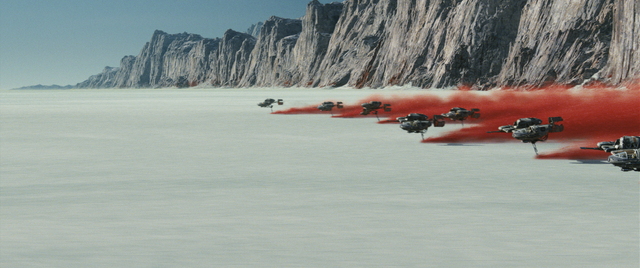
Movies are notoriously bad at getting science right. Star Wars is a notorious offender, especially when it comes to geology- which I've written about before. I love Star Wars, but they just never get the geology right. Crait, from the Last Jedi, might be my favorite Star Wars planet ever- but does it make sense geologically?
The filming location of The Last Jedi, the Salar de Uyuni in Bolivia, is the world's largest salt flat, dwarfing the salt flats in Utah. It's a harsh environment, to be sure- in fact, I'm going to include it in my Most Hellish Places on Earth series, so this post serves a double role. The ground is literally covered in salt- no plants can survive there, and no animals can live there year round. It is, for the most part, as dead as either of the first two entries in that series.
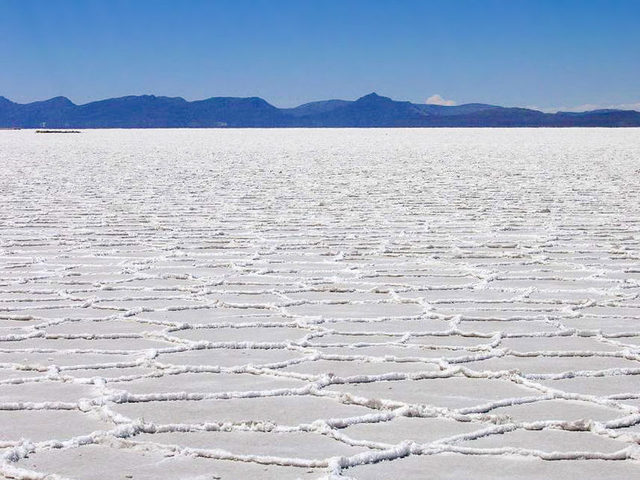
The Salar de Uynui, where the Crait scenes in The Last Jedi were filmed. [Image source]
The Salar de Uyuni is also incredibly flat. In fact, it's the single flattest place on Earth. And though you'd think it would be found in some lowland, it's actually in the Andes Mountains. And while it's dry as a bone all summer, during the rainy season the entire salt flat is covered by a thin layer of water, creating some truly bizarre visual effects.
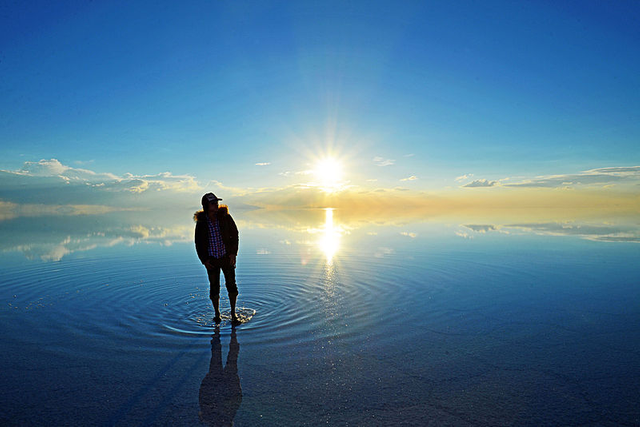
Salar de Uyuni during rainy season. [Image source]
Salar de Uyuni, however, is different from Crait in several key regards. Most importantly, there's no red layer underneath Salar de Uyuni's surface. Instead, there's a layer of brine saturated sediment below the crust. This brine is actually economically valuable- there are large quantities of lithium in the salt of Salar de Uyuni, and it's most easily extracted from the brine. In fact, as much as 40% of the world's lithium reserves are found there. The sodium itself of the salt is also valuable, and potassium, lithium, borax, and magnesium are also present.
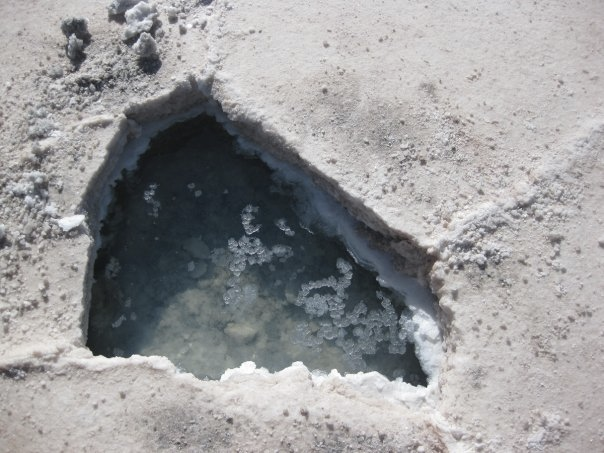
Below the surface of the Salar de Uyuni. [Image source]
So is the red stuff beneath the crust of Crait's salt flats possible? In fact, yes, it very much is. There's a type of salt known as sylvite that is that exact shade of red. Instead of sodium chloride, the salt we use most often, sylvite is potassium chloride. It's an isomorph of sodium chloride, however- they have the exact same crystal structure. Could the salt be deposited in the two layers like that?
In order to understand that, we've got to understand how salt flats form. Essentially, they occur when lakes evaporate away, leaving the salt present in all water to crystallize out. As more and more water evaporates, the remaining water gets saltier, and the salt crystals begin to form. This process doesn't work if the lake drains- only if it evaporates.
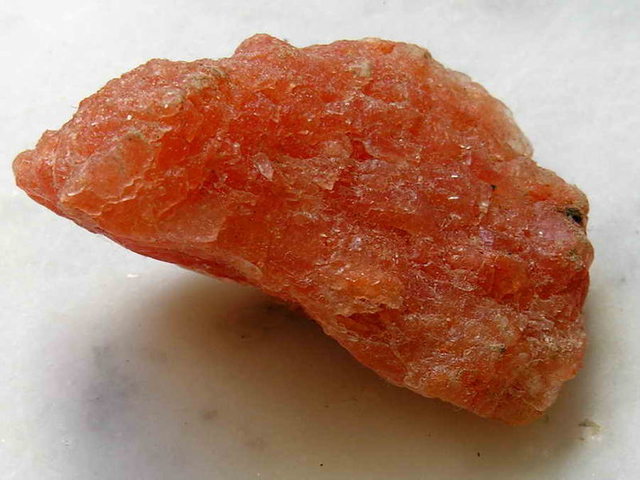
Sylvite. [Image source]
Because of this, it turns out that there are actually a few ways the red and white layers could occur. One likely scenario involves simply different dissolved minerals and water chemistry than occur on Earth. It's also possible there's something in the atmosphere leaching potassium but not sodium out of the surface. Or the red stuff might not be sylvite at all- maybe it was salt dyed red by some sort of algae or bacteria, which could no longer reproduce once the water got salty enough, so the upper layer of salt formed without them. Or it could just be a bright red soil, with only the top white layer being salt. Heck, it could even be radiation damage, which can change the color of salt, and then had more salt recrystallize atop it. It's somewhat hard to know which of these it is without actually getting to investigate the geology of Crait firsthand.
So the red-under-white salt plains of Crait work just fine geologically, it turns out! And the crystal filled caverns? Well, assuming they're salt crystals, that works just fine. Even more possible, they might be gypsum crystals, like in the Cave of the Crystals in Mexico. Gypsum crystals, like salt crystals, are evaporites. (Evaporation generated minerals.)
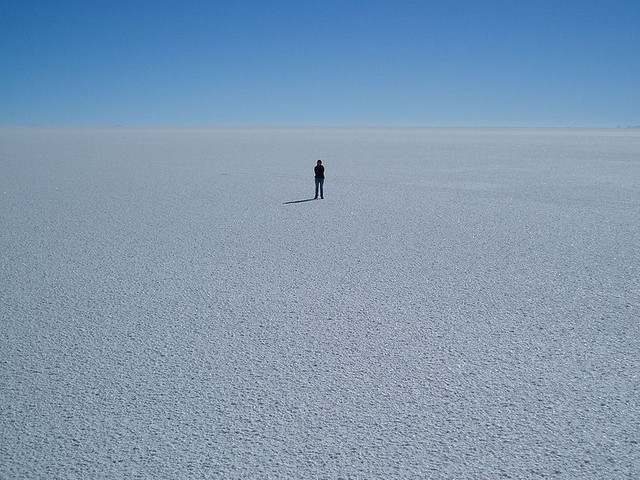
Another view of the Salar de Uyuni. [Image source]
All this brings up an interesting question, however- in order to produce this many evaporites across, presumably, an entire planet (because all Star Wars planets have only one type of terrain, for some reason), something had to happen to this planet's water. It all had to evaporate somewhere. We know there are still some small oceans- they're visible from space, and some of the canon extended universe material mentions that the Rebel base is on the northern continent. The most likely solution? Crait was a world of widespread seas, and is in the middle of a SEVERE ice age, and most of the water is locked up at the poles in enormous ice caps, greatly reducing the range of the seas. Alternatively, if the red layer is made up of salt crystals reddened due to radiation damage, Crait might have been subjected to some apocalyptic stellar event that stripped away much of the planet's water.
Final verdict? Crait's entirely geologically possible! And heck, it's not the only one, either- all the other planets are geologically entirely possible. Luke's planet with the islands (assuming there are some larger ones somewhere, it works), Canto Bight, and the lush rebel planet from the beginning are all perfectly geologically plausible. There aren't really a lot of other geologically plausible planets in the series, so I'm really impressed. Yet another reason why I'm a fan of The Last Jedi!
Bibliography:
Star Wars: The Last Jedi
http://starwars.wikia.com/wiki/Crait
https://en.wikipedia.org/wiki/Salar_de_Uyuni
https://en.wikipedia.org/wiki/Sylvite
https://en.wikipedia.org/wiki/Salt_pan_(geology)
http://www.adventuresinpoortaste.com/2017/12/15/reality-check-geology-of-star-wars-the-last-jedis-planet-crait/
https://earther.com/the-amazing-earth-science-behind-the-last-jedis-new-min-1821429894

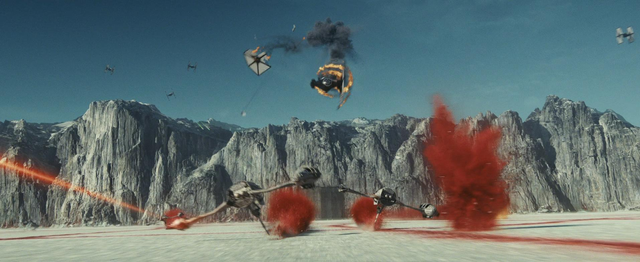
I will first admit that I am only a casual Star Wars fan, so I do not have much familiarity with which terrains correspond to which planet in their galaxy. That being said, I did notice the phenomena of single-climate planets in earlier films and it made me begin to wonder which condition would occur most naturally: a diversified planet such as our own, or a Star Wars planet model.
I understand that there were plenty of people who were upset with the direction of this film from a character perspective, so I am glad that even if that was the case for you as well, you were still able to find a silver-science-lining :)
Oh, I actually loved the movie! My only complaints were minor quibbles.
Diversified planets like our own are ABSOLUTELY mlre capable of supporting life. There are a lot of more homogenous planets like Mars or the Moon out there, but they sure don't support life like Earth.
Glad to hear you enjoyed it so much.
Hearing statistics about life-sustaining planets makes it that much more awesome to even exist to know this information. Thanks for the great post and quick reply, looking forward to more of your content.
Thanks for reading!
Great post! As I was watching the movie the same exact thoughts were crossing my mind, lol. I'm glad you decided to touch up on it. I may have to begin watching certain movies to see if I notice any geological abnormalities as well.
It's a lot of fun, especially with bad natural disaster films.
I instantly though KCl when I saw the red shooting up from the salt flats as well.
See, my first thought was actually the dead microorganisms packed in the lower layers of salt idea.
Something like the krill in pink brine that turns the Flamingos pink? That's plausible too. Are you a working Geologist? I'm studying Geology at OSU as we speak!
Nope, I'm a geology student at Portland State- we're practically neighbors!
beautiful natural phenomena again, I start liking geology - wtf?^^
Btw: What is the most unrealistic Star Wars planet you ever encountered?
Oooh, good question. Coruscant is pretty bad- global city planets DON'T work. It would produce nightmarish weather patterns, pollution, etc, especially given its lack of oceans. Tattooine wouldn't work- not enough plants to produce oxygen. Kashykk wouldn't work- too MUCH oxygen. (There'd be giant forest fires all the time.) Hoth would also have little oxygen, though it isn't quite as implausible as the others. Mustafar is pretty absurd in some ways too- it'd have to be super young to have that much magma everywhere, and planets that young wouldn't have topography that interesting.
Good planets (apart from the four in this movie) include Yavin 4 and other "boring planets." Rogue One's planets were mostly fine, for instance.
And as for liking geology- it's a pretty easy topic to like, once you start delving into it!
Nature is something isn't it?
I had written about Salaar de Uyuni and the crystal cave in Mexico on my phenomena series.
Oh, nice! Yeah, I've seen several posts on the Crystal Cave, which I can't blame people for- it's one of the most sensational geological wonders on the planet.
Thanks for sharing this! It's always interesting to compare what you see on screen to actual phenomena. Certainly it doesn't have to be plausible since it's an imaginary universe, but since most fanciful things have grounding in reality, I find analyses like this post to be fascinating.
Keep up the good work! Your posts never fail to teach me something new!
Thanks! And yeah, while plausibility isn't required, it's fun when it is. Would you be interested in more movie science posts like this one in the future? It was a lot of fun to do.
Most definitely. I enjoy science, and I enjoy movies. Even if I hadn't seen the movie, I'm sure this would have been interesting!
Consider it on the docket, then!
My family are so bad at tearing apart movies trying to find out whats possible and not! You took it to a whole other level!
Hah, I'm a pretty big nerd- I enjoy doing stuff like this!
I remember as a child, my dad would watch western movies. He used to get so irritated with me when I would point out power lines or cars caught in the shots! hahaha Its different but kinda the same!
Hah, nice! My dad used to watch those same Westerns, I bet! (I saw everything from the 50s to modern stuff with him.)
This is outstanding! I thought it was pretty ridiculous when i watched the movie, but your awesome scientific explanation for its plausibility was just as entertaining. Brilliant idea for an article; well done Mountain. Science and Star Wars, who knew they'd pair. :grin:
Not I! It was a surprise pairing. And thanks, glad you liked it!
Ahh I know that feeling. Some of the Bollywood Movies are of the same like Star Wars, we science graduate just could not digest the fact and find it quite hilarious.
Yep! My geology classmates and I sometimes have movie nights where we watch the least scientifically accurate movies we can find.
Hi @mountainwashere - I have a baggy of potassium chloride salt, bought from the chemist, which tells me its genuine. But it is as white as ordinary salt. So is the so called "Pressor Salt", claimed to contain the same, I have bought on occasion from the grocery store.
Will it turn red like the 'sylvite' you mention if I were to recrystallize it? What could it be causing the different appearance - Just the size of the crystals?
Btw, talking MarkDown editing stuff now - you can prevent your intended dashes from turning into hyphens by inserting a backslash in front of it as you edit your posts - like this:
\-. The backslash will show only in your editor window and not in your published presentation.White potassium chloride is pure, it's given its color by mineral inclusions- much like halite (sodium chloride) can be other colors as in Himalayan salt due to similar mineral inclusions. That shade of red only really occurs in sylvite, though, not halite.
YES I TOTALLY INTENDED TO PUT IN DASHES INSTEAD OF HYPHENS THIS IS A THING THAT IS TRUE AND NOT JUST AN ADDICTION TO UNNECESSARY AND WEIRD PUNCTUATION IN MY often OVERLONG SENTENCES RATHER THAN JUST DIVIDING THEM UP.
Ahem. Yes. That.
...had finicky me at wit's end till I discovered the answer in a MD help page - some really elegant subtleties woven into the fabric of this technology by the invisible scripting brigade behind the scenes...
I figured out half the stuff in markdown accidentally, like how to make a bulleted list.
So did I - what a battle! Then I came across a post suggesting downloading an app for creating posts offline. There are a host of these available for different operating systems. I eventually settled for MacDown on my MbP and their help page is very helpful indeed - even tables are made easy in there.